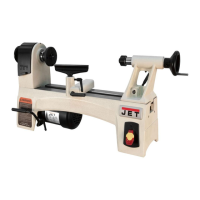Fig 5
“Low” speed range (200~1050 rpm) for maximum torque.
“Medium” speed range (300~1750 rpm) for general use
“High” speed range (600~3600 rpm) for maximum speed.
Caution:
Always set the speed control knob to its lowest setting before
starting lathe. Never start a workpiece at maximum speed.
LED light (B) displays “green” during normal operation.
LED light (B) displays “red” due to overload
LED light (B) displays “red” and “green” in case of error.
…see chapter 9.
6. Machine operation
The information which follows is general in nature and is not
intended to be a complete course in wood turning. Nothing
can replace the knowledge gained by conversation with
experienced woodturners, or consulting books or trade
articles.
6.1 Correct operating position
Always support the tool on the tool rest and guide with the
palm of your hand keeping your fingers closed.
(see Fig 6)
Fig 6
6.2 Tool selection
Successful wood turning does not result from high speeds,
but rather, from the correct use of turning tools.
A perfect and sharp wood turner tool is a precondition for
professional wood-turning.
Major tools:
Fig 7
Gouge (A, Fig 7), used for rapidly cut raw wood into round
stock, for turning bowls and plates, for turning beds, coves
and other detail (Fig 8).
Fig 8
Scraper (B, Fig 7), used for diameter scraping and to reduce
ridges.
Skew Chisel (C, Fig 7), used to make vees, beads, etc. (Fig
9). The bevel of skew is parallel to the cut.

